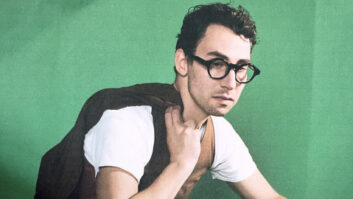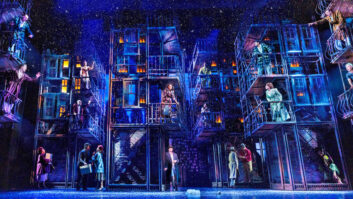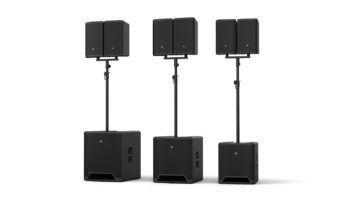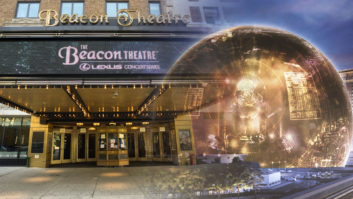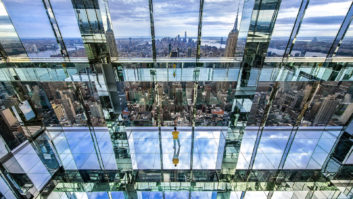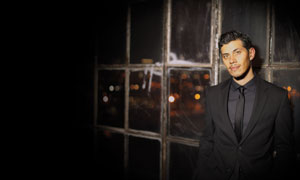
Photo: Michael Vecchio
Dave Tozer is a true music junkie, and his passion is infectious. Writing, recording, arranging, producing, editing, mixing—he just thinks of music that way, as a complete picture, a visual, a mood, a vibe, an emotion. From the concept of the song, to building the melody, rhythm and lyrics, he conceives of the process as one unified piece. You can almost see him flipping the sheets while conducting a big band at the Copa, bopping and waving his arms. Music with style. Music as a moment.
He also lives the life. Walking the streets of New York, 10 minutes to his Night Fox studios. Calling Mix on his way to mix at 11 p.m., later finishing a track for a UK artist on New Year’s Day. He collaborates, records around town, knows the musicians. He’s known primarily for his work with John Legend, and theirs is a great story going back to the late-‘90s in Philadelphia, but he’s done so much more, with both A-listers like Kanye and Justin Timberlake and Jay-Z , and with new artists on their way up. He writes, plays, produces, records and mixes in various combinations depending on the project. For Legend’s projects, including this year’s Grammy-nominated, Love in the Future, he does it all.
While his music and recording story might seem typical—small-town kid falling in love with guitar, parents who listen to a variety of music, a Tascam 8-track and then an internship at a studio—the path was infused by music, making music, “just for the love of it.” Late-night jam sessions, getting bands together, playing out, shopping demos, picking up the Yellow Pages, writing songs, calling A&R reps. He didn’t know the rules. But he did come of age at the vortex when rock began to wane and hip-hop exploded. He loved them both, and again, he lived the life. He immersed himself in the scene. He ate, slept and breathed music. He crashed on friend’s floors.
And now he’s having fun, doing what he’s always done. He can dig deep technically as well as anyone you will meet, and he is well versed—mostly self-taught—in the fundamentals of recording and music. But it’s the spirit and the scene and the vibe and the voodoo of making a song, from concept to distribution, that drives him. But back to the beginning…
So what brought you into music, then combining it with recording and producing? What was the drive?
In hindsight, I was always an artist in some way. I was always interested in art. As a kid I used to draw a lot—would copy the album covers, taking a plain piece of paper and put it over the top of the album cover and trace things. My dad listened to a lot of old rock ’n’ roll, and I can remember tracing the Rossington Collins Band. They had this album, and on the front was this sort of bird, and this weird little font, and flaming…I distinctly remember tracing that cover. Eventually I stopped tracing them and started drawing them by eye. I was always into various arts. That makes sense to me now in looking back, and how recording fits; it’s a sonic art.
Did you want to write music back then?
No. I didn’t write straight from the beginning. It was more guitar. I was really drawn to the guitar—it was so accessible, and I just loved it so much. My friend’s dad had one in his attic that he wasn’t using, so I asked if I could borrow it. I sort of claimed it as mine. It was strung left-handed, so I think we restrung it, or I started playing it upside down right-handed or something, but eventually I got it sorted for right-handed, and I remember the action set really high so it was really tough on your fingers. It got my fingers tough really quick. I would ask a friend or two about chords. I never took formal lessons, but I studied it on my own and eventually I sought out the answers and tried to understand. I had a basic understanding of theory and whatnot.
Were you by yourself at this point? Or were you bouncing off people?
A lot by myself. It wasn’t as much about recording then as it was about reproducing a song on the guitar, to play the intro for “Over the Hills and Far Away” by Zeppelin. Those were the things I was trying to learn. I got into recordings because I was essentially studying recording to learn guitar parts. I would have my CD player, and I would rewind it a little bit to learn a part, and keep chipping away it at until I learned it. Eventually it went beyond the guitar and I started to try to understand what the bass parts were doing, or what the drums were doing—I was dissecting arrangements. I didn’t quite know I was doing that at the time, but that’s what I was doing. I remember doing it with Marvin Gaye tracks. I’d study the notes and try to understand why things did what they did. If I couldn’t figure it out, I’d look it up in books.

Dave Tozer in his Manhattan recording studio.
Photo: Michael Vecchio
It’s how parts are fitting together…
Exactly. In hindsight, it probably would’ve been a lot easier for me to pay for lessons, but I never did. [Laughs.] In a lot of ways, what was exciting to me about music was that I didn’t have to do it. It was my own thing that I was drawn to.
And the music? What were you listening to early on?
Early on I was drawn to a lot of rock ’n’ roll because it was around my house. My parents played a lot of classic rock, things like The Beatles or Led Zeppelin. My dad was also listening to things like Blue Öyster Cult, The Marshall Tucker Band, The Allman Brothers, Pat Travers, Rory Gallagher, Stevie Ray Vaughan. Even if I wasn’t consciously paying attention to it, it was there. And then as a teenager I got into a lot of hip-hop because that was the new music. I was really taken with it. I remember being profoundly impacted by the first 3rd Bass album, around ’88-’89, and also the early N.W.A. stuff, the Eazy-E album and Straight Outta Compton. And there was an album by The D.O.C., which was also produced by Dr. Dre. I was also listening to what they call “conscious rap”—I loved KRS-One, all those Boogie Down Productions records, A Tribe Called Quest, a lot of that Golden Era Hip-Hop. I was in rural/small-town South Jersey, so a lot of that stuff was fascinating to me. I was into the edginess of that music. Same with early rock ’n’ roll. It had an attitude that I was into. After I became a musician, I got into soul music and a lot of Motown. Once I became a guitarist, I really got heavy into the blues, and I started to realize that’s the core of everything that I liked. I started tracing the early Stones and Zeppelin records, all the way back to Muddy Waters, Howlin’ Wolf and Robert Johnson.
When did you discover technology? When did you pull out your Portastudio?
Actually, the very first thing I had was a little boombox with a cassette player in it. I would put a cassette in and record myself playing a rhythm part. Then I would stick that cassette, into the home stereo system, play that out of the speakers, put another new cassette into the boombox, and hit Record. There’s nothing better than hearing yourself play on top of another part you recorded—that is serious fun. Then a little later I got a Tascam 8-track, a 488 Mark II, which was unique because most people had 4-track. The beauty of those Portastudios was that you could just record right on cassette. The first thing I did was put down a drum part—with my Alesis drum machine— then maybe a bass part and guitar parts. Initially I was just copying songs—I wasn’t writing anything. Eventually I started writing my own stuff, I started making up my own licks.
This is all in South Jersey? What brought you to Philly?
I moved to Philly because it was the nearest big city, and I had a friend who went to Drexel University. I went to visit him and thought, “Philly is cool.” I just moved into a place in West Philadelphia right on University of Pennsylvania’s campus, and tried to immerse myself into the music scene; there was so much going on.
I went to jam sessions, things like that. I’d meet people, go back to someone’s place and we’d have a jam session. It was quite a fun time—just meeting a lot of people and playing music just for the love of it. We weren’t really thinking about making music per se; we were just thinking about impressing our friends. Picking up a lick from somebody else. It was a community.
Do you start to look at studios? Think about recording? Do you meet John?
It’s funny. I got the Yellow Pages, and I looked up recording studios. I found this place called Sonic Recording on Delaware Avenue. I just went there one day with a demo tape of me playing guitar, and I said to the studio manager, “I’d love to get some session guitar work if there’s any going on.” A couple days later he said, “Your guitar work is good. Just so you know, there’s a lot of guitar players around here, but if you’re interested, we’d love for you to intern.” I said, “Sign me up! I’m in! When do you want me to come? I’ll come right now!” [Laughs.] This was shortly after I moved there. That was the beginning of me seeing what a proper studio was like. They had a couple of rooms, one was a really big live room. They were cutting to 24-track, 2-inch tape, big SSL console—it was the full thing. That was my entry into the studio world and studio etiquette.
But the reality was, I really wasn’t trying to be an engineer. I was trying to get into the scene, but I was more interested in creating music. But working at the studio was invaluable—learning the studio etiquette and the dialog. Later on, once I did produce records, I knew how to talk to engineers as a result of that experience.
How did you meet John? How has this relationship evolved?
A mutual friend—journalist Max Blumenthal— was at University of Pennsylvania. Max and I started hanging out and listening to records. He played drums and had a great music collection. He turned me onto things like Frank Zappa and Nina Simone; we started listening to the Portishead Dummy album. He told me, “There’s this kid at my school, John Stephens, he’s a pretty good R&B singer. He’s a pretty straight-laced guy. But you should meet him.” [Laughs.] We had this bass player friend of ours, Nathan Sabatino, who went on to engineer and produce Dr. Dog, he had this basement setup where we could all play music. So we said, “Why don’t we invite John over there?” So he came by. John played a little keyboard, I played a little guitar, we sang some songs—some Smokey Robinson and Stevie Wonder tunes—and I thought, “Okay, this guy is pretty good. He’s cool.” I heard a demo of a song he had written, called “Just in Time,” and I thought “Wow, this guy can write, too!”
By this point I’d started to become a songwriter myself. When I heard this great song, alarm bells were going off in my head. We started hanging more, and I think I’d hired John on some gigs—I would get hired to put bands together for gigs in town. I remember we did a gig at a restaurant one time in Philly—it was an outdoor thing, people were eating inside, and we were outside “testifying,” as it were, doing our thing…[laughs] And the maître d’ came out and said, “Can you have the singer stop singing?” It was basically too much for the dinner crowd inside! We carried on the rest of the gig just playing instrumentals. I’m sure John wasn’t very happy about that. [Laughs.] But that’s the guy who became nine-time Grammy winner John Legend! Getting asked to stop singing at a restaurant!
We were a good combination. Even early on, we were writing very good songs together. I think about the demos we did around the year 2000-2001, and when I hear those now—the production wasn’t too good, it was very primitive—but the actual writing itself still holds up pretty well. I knew we could really do something together and I could focus on his project. Between writing songs, rehearsing a band, producing the demos, shopping material, it was a full-time project. In some ways, I was almost too naïve. I didn’t have a backup plan.

Tozer likes his productions to have a mystical quality and what he calls “the voodoo.”
Photo: Michael Vecchio
Tell me about his voice. What’s your take on John’s voice over the years?
He just has a wonderful voice. And not just a great voice—he’s a great singer. They are two different things. He’s got this great, unique instrument, and he knows how to use it. He’s been a musician since he was 5 years old. He knew what proper phrasing was. He was steeped in soul music and gospel. He knew what proper harmonization was. He has such a great instrument, and that makes capturing it relatively easy.
I’ve learned more about miking over the years just experimenting with him. At a certain point I came to realize that what I really liked on John was a [Neumann] U 47. John has some good growl in his voice, and that mic has a nice upper-midrange bite. With regard to the signal chain, the U 47 into a Neve 1073 or 1081 classic pre, then a [UREI] 1176 or [Teletronix] LA-2A compressor…mostly an 1176. Then going into the console. I also do a lot of recording to tape. He sounds really good going through a tape machine, getting some of those upper harmonics.
DAWs and emulations and virtual instruments have come a long way since you first began dabbling in songwriting and producing. Does the technology inform your arranging?
I like to be simple. Your songwriting still has to be great with just a voice and a piano. I’m still into songwriting in the classic sense—I wanna hear great chord changes, I wanna hear melodies, I wanna write great lyrics. But what’s really cool about some of this technology is that it can inspire the writing. You can pull up these sample libraries or a software synth or anything around you. Maybe you have a preset that does something weird you didn’t expect. Sometimes it could just be one sound that’ll inspire the whole record. When I started a song with John called “Asylum,” that whole musical bed, the whole production started from an electronic kick-drum sound that was on a patch that I pulled up. And those are the times when it’s really fun to have that close by.
Do you still love recording guitar?
I do! Guitarists, maybe more than other instrumentalists, are really dialed into the tone of their guitar. I love recording guitar with great tone. There’s an intro, on the Love in the Future album, where just John and I did a live, off-the-cuff bit with me playing guitar and him singing. We cut it together, but that was me playing through my ’68 Fender Deluxe Reverb, silverface with blackface circuitry in it. It’s a great classic amp. And I’m playing an old-school Gretsch Country Gentleman, and it just has that sound, and it has a slapback analog delay on it. It almost has that ‘50s guitar sound, real murky. It just inspired that performance. That’s the key—you want the feeling. I deal with feeling and emotions when I’m making music.
In capturing that feeling, you’re a Logic guy in a Pro Tools world. Usually we think of Logic for writers and arrangers.
My first DAW was Pro Tools. I learned all about Pro Tools and got really fast on it. And sometimes I still use it, but Logic is my preference. What happened with me is, I realized I was having a lot of workflow problems with Pro Tools. Syncing problems when using external hardware like the MPC, and I just felt like I wasn’t making recordings sound great in it. It’s a great blank canvas, and it could be that my own skills were limited at the time. But however it came to pass, I was frustrated. I was talking to Toby Gad, another songwriter/producer, and he said, “Why don’t you try Logic? Give it a week, try a song on it, you won’t turn back.” This was back in 2007. I took my time learning, and I realized in short order that there are a lot of benefits to it. As somebody who creates and records music, it was a better one-stop-shop for me. And the stock plug-ins that come with it are better. There’s a learning curve to it. It’s like being bilingual, you have to learn a completely different language. But if you take the time to really learn it, you are rewarded.
Now a lot of people are creating in Logic, then bouncing tracks out into Pro Tools for people to finish, record vocals. But I don’t see any point in doing that. You can do that just as well in Logic and keep it all together. I recorded and mixed the whole John Legend album completely in Logic.
What’s your front end like?
I use Neve a lot, Neve pre’s, I have a Universal Audio 610 preamp I like a lot for the tube stuff, an 1176. I love TubeTech compressors and EQs—they’re modern vintage gear. I also love the sound of tape. The records I love so much are from the ‘60s and ‘70s, those recordings have so much character. Where does that come from? Well, it comes from the tape, the way you hit the tape, it’s coming off of the console—Neve, EMI, Trident, Helios—they all have their little characteristics. It’s coming from the microphones, from the instruments. The point is, by the time you get all the way through to recording on the multitrack, running it back into consoles, mixing to another ¼- or ½-inch reel, then pressing for vinyl, you’ve got a lot of the medium imparting character. We don’t have any of that now. DAWs as a medium do not really impart a character on the sound, so we have to add it. That’s the key. That’s where I feel I’ve gotten good at it over the past 5 to 10 years. I got much better at knowing how to add that character. I like tape machines that add a lot of character. I don’t want it too clean from the tape machine. And it’s not just about having the tape machine; it’s also knowing how to hit it.
With a real tape machine, I’ll take a signal—and I did this a lot on this last John Legend album—and I’ll record it direct into Logic. And then I’ll also record it to tape at the same time. And I’ll monitor it from the repro head, make sure I’m getting the sound we want, and then I’ll record that through. But as we’re recording, we’re monitoring the digital signal because the tape will have a latency from the tape head to the converter and going back in. Once I get both recorded, if you look at the waveforms, the tape signal is a little bit behind because of the latency, so then I just use the digital signal as a waveform reference, and I manually move the tape track and line it up to the digital. It’s basically a manual version of CLASP.
You’ve worked with huge artists like Kanye, Justin and John Legend, but you also work with lesser-known, up-and-coming talent. Can you tell me about your production approach to both?
I like working with a mixture of new artists and marquee artists. The fun thing with new artists is you have an opportunity to bring something fresh and new to the table, and help somebody come out to the world. Generally speaking, new artists tend to be a little more insecure than more mature ones. Being a producer isn’t about making great beats or arrangements, it’s really about the art of psychology. [Laughs.] You have to find a way to build trust with a new artist—with any artist, for that matter—but particularly with a new artist. Get them to drop their guard, get them to know that you’ve got their back, that you’re gonna go through this process with them. And while you’re trying to get them to let their guard down, you also have to hold their feet to the fire. If things aren’t good enough, you gotta make them do better. Sometimes that might be a tough pill to swallow.
Who are you working with now?
I did a song for Kimbra’s new album. Kimbra is the artist who worked on Gotye’s “Somebody That I Used to Know.” I just produced a song with Ella Eyre from the UK, who worked with Rudimental. I’m getting ready to start an EP with a new artist from Toronto named Kai, writing and producing. She’s a young pop artist with a cool, soulful sensibility. Kind of like Lorde a little bit, but she does her own thing. She writes, she was featured on the Diplo track “Revolution.” She’s got a great voice.
SIDEBAR: NEW YORK NOW

Tozer, left, and Troy Germano in Germano Studios Studio A.
Photo: Michael Vecchio
Since moving to Manhattan in 2009, and opening his own Night Fox Studios, Tozer has had a front-row seat to the rapid changes in how records are made in New York City. The recording studio landscape has changed dramatically, with some of the world’s finest commercial facilities closing their doors. At the same time, he’s seen first-hand the rise of Brooklyn, the re-birth of a local music scene, and the settling in of some familiar recording studio favorites—including a couple that he tends to record in most often: Electric Lady, host of this month’s cover shoot, and Germano Studios, where he likes to work out the Ampex ATR-102 ½-inch tape machine.
“New York is fantastic,” Tozer says. “I love it here. I love living here, and the scene is great. A lot of people will tell you the studio scene here isn’t what it once was, and that’s true to a certain degree with a lot of bigger rooms closing down, but I think the studio and musician scene here is vibrant. There are a lot of rooms in Brooklyn, and there are a lot of rooms in Manhattan.
“But the great thing is you don’t need big rooms all the time now,” he continues. “It can be a mix between bigger rooms and project rooms. I’ll work at Germano, I’ll work at Electric Lady, I’ll work in my own studio for a variety of things. Outside of my own room, Germano is my favorite studio to record in, and though I love the rooms, gear and service, the main thing about Germano Studios is Troy. He is world-class. Because he has such great history and experience, working with his father, Eddie Germano, with the Hit Factory franchise, he really knows the studio culture so well, and it trickles down to how well he trains his staff, and how well he maintains his relationships with artists & producers. And although his studio has classic gear, he knows how to keep a studio looking forward,which I think is reflected in his ability to thrive as a studio owner in Manhattan, when other on his level have struggled. He’s a great friend of mine. He’s not just some guy who runs a studio. He loves this shit!”
SIDEBAR: LOVE IN THE FUTURE
While firmly rooted in classic gear and techniques, using everything from ribbon mics to tape and vinyl, Dave Tozer also embraces the most modern recording technology. Here are ten examples from John Legend’s Grammy-nominated Love in the Future that demonstrate his unique amalgam of classic and modern styles.

Tozer printed the “Love in the Future (Intro)” to vinyl and recorded it back into Logic for the master.

The otherworldly filtered sound of Legend’s vocals in “Made to Love” was achieved with Soundtoys Decapitator; adding drive and low and hi cuts, Waves SSL Channel EQ and filtering at 200 Hz, 3.5 kHz & surgical cuts with Logic’s Channel EQ.

The reverb and delays that lend to the psychedelic vibe of Legend’s and Kimbra’s vocals in “Made to Love”: UAD EMT 140 Plate with filter and predelay, UAD Cooper Time Cube set to 1/16-note and 1/8-note panned delays, and Soundtoys EchoBoy adding an analog style 1/8-note delay with some under-the-hood tweaks.

The swirling vocal delays in the “Made to Love” outro: EchoBoy ½-note delay into Soundtoys Panman and Echoboy ping-pong ¼-note through Soundtoys FilterFreak. The Echoboys each have different settings and tweaks. These are combined with the other lead vocal effects.

Tozer used a combination of programmed and live drums for “Asylum,” including a sub kick and white-noise snare sounds.

Tozer recorded live drums for “Asylum” at Germano Studios. The combination of mono Royer 122, pair of Coles and rare pair of Telefunken Cinemics were blended to 2 tracks and recorded to Ampex ATR-102, then to Logic. Notice that only the stereo Ampex tape blend is being used.

Tozer used a combination of software synth on “Asylum.” The backwards pad sound that runs throughout is from Arturia Jupiter 8V. The main vocal ahhs and boys choir pads are from Gforce’s MTron Pro. The circus-sounding synth arpeggio is Arturia Arp 2600V. And the high string pads are Gforce’s Virtual String Machine.

For the robot voices in “All of Me,” Tozer used the TC Helicon VoiceLive 2. The various settings are detailed in session notes. Then the tracks were bussed to an aux track and processed with UAD Neve 33609 compressor, UAD Neve 1081 EQ and Soundtoys FilterFreak, in addition to UAD Fairchild and Waves Q10.

On “Who Do We Think We Are,” Tozer blends baroque instrumentation such as harp with sample-based hip-hop production. At Electric Lady.

Tozer used a vintage Roland TR-808 throughout the LP. Also, most everything was recording to the Ampex ATR-102 ½-inch machine, then sent to Logic from the repro head.
